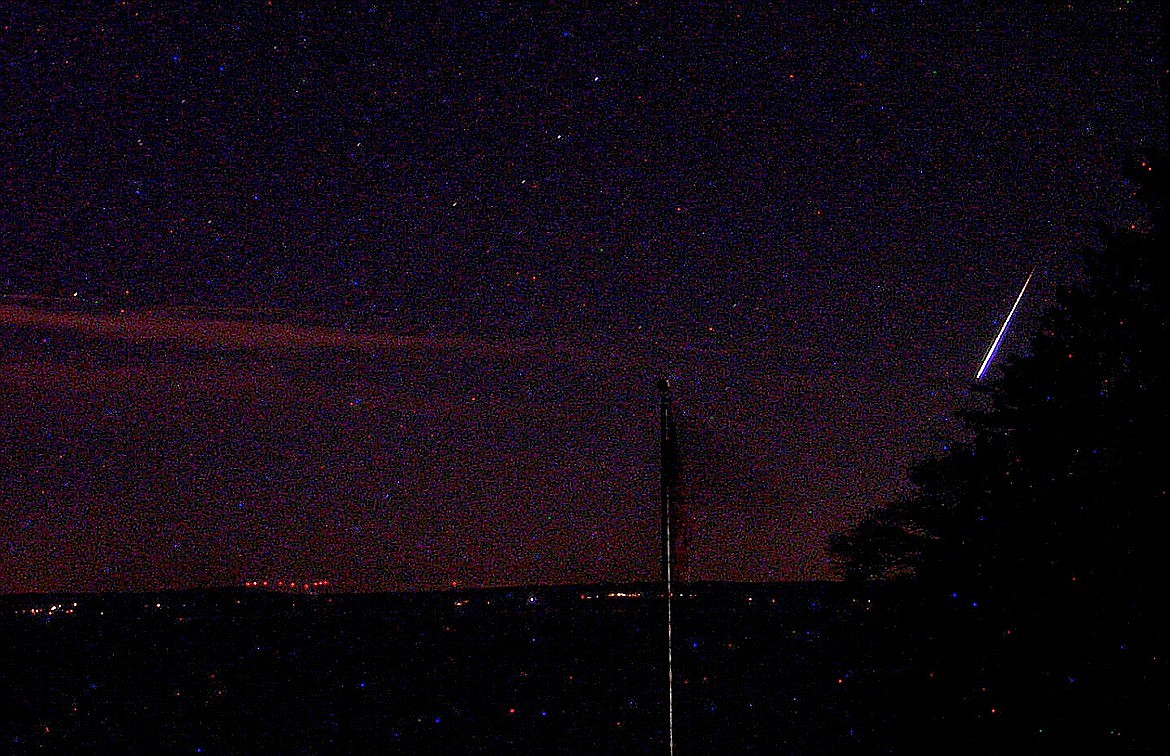Early risers catch glimpse of meteor over Montana
Early risers Thursday morning may have caught a glimpse of a spectacular fireball seen from Missoula to north of Calgary at 6:26 a.m.
The meteor produced what many on Facebook described as an “explosion in the sky” as it traveled from the southwest to the northeast, resulting in dozens of reported sightings.
According to Bill Cooke, lead of NASA's Meteoroid Environments Office (MEO), the meteor was first detected by NASA 52 miles above Ford, a small community in Beaverhead County, moving almost due north at 47,000 miles per hour. The meteor traveled 75 miles through the upper atmosphere before breaking apart 47 miles above the Flathead Mountain Range on the border of British Columbia and Alberta, Canada.
The event was bright enough that three National Oceanic and Atmospheric Administration (NOAA) GOES satellites recorded the meteor with their lightning detection instruments.
While radar operators from NORAD, Malmstrom Air Force Base and the National Weather Service say their radar missed the identified flying object, they all pointed out the incident may have happened too quickly to be recorded by their equipment.
Local reports of the fireball came in from Lakeside and Somers to Kalispell, Whitefish and Kila while other sightings were reported in Big Arm, Polson and Libby.
The American Meteor Society received 23 reports of the fireball from Montana, Idaho and Washington as well as British Columbia and Alberta.
The reports ranged from as far south as Lolo in Montana to Calgary (where videos were captured by Michael Power and VSW) and Golden Alberta, Canada to the north. Sightings popped up in Coeur d’Alene and Spokane and as far west as Fernadale, Washington and Maple Ridge, British Columbia, Canada.
According to Whitefish’s Jack Fairchild, the meteor filled the dark early morning sky like daylight.
“I was walking in the neighborhood in the dark and the street just lit up with a white light,” he said. “I was surprised, so I looked up into the sky to the north and in the sky the meteor was still streaking. I could see six or seven inches of tail and the meteor was glowing like a just lit match. It was by far the largest and brightest meteor that I have ever seen. It lit up the entire area.”
Chris Woody was working when he saw the sky light up.
“I was at work driving around up in the Iron Horse subdivisions when I saw a shooting star and I thought it was pretty cool as it was my first time seeing one. About ten minutes later I’m still driving and then out of nowhere the sky flashes green and then returned to normal a second later,” he said. I was shaking because I didn’t know what it was and I was waiting for some kind of reaction to come after but nothing came.”
Brodie Verworn was driving to Libby when he witnessed the meteor.
“I was in Smith Valley and night turned to day for one second, and then it was done,” he said.
While NASA scientists estimate that as many as 25 million meteors hit the atmosphere every day and 48.5 tons of meteoritic material falls on the Earth every 24 hours, most are no bigger than grains of sand.
As for the size of Thursday’s meteor, Cooke says that is hard to determine.
“It’s hard to estimate size on these things. It’s probably in the order of maybe a foot across. We just don’t have enough data right now to say for sure,” he said. “It doesn’t take something very big to produce a large streak of light in the sky when it is moving 47,000 miles per hour.”
While the night skies are currently filled with meteors from four active meteor showers, the Orionids, Southern and Northern Taurids and the Leonids, Cooke is convinced Thursday’s fireball did not emanate from any of them.
“It was way too slow to be a Leonid. It was what we call a sporadic or background meteor that was not associated with any meteor shower,” he said. “Leonid meteors travel at around 170,000 miles per hour and this puppy was fairly slow compared to that.”
The debris left behind by comets that cause meteor showers is usually very small and hits the Earth’s atmosphere at anywhere between seven and 44 miles per second.
Most meteors occur in Earth’s mesosphere, about 31-50 miles above the Earth's surface and can appear in different colors, depending on the chemical composition of the space rock and the air it is passing through. A meteor with high iron content, for instance, will appear yellow. A meteor with high calcium content may appear as a purple streak of light.
The light from a meteor traveling through the atmosphere is called a trail and usually lasts only a fraction of a second while the smoke-like gasses left behind, called trains, can be visible for as long as 30 minutes in some cases.
Any meteor brighter than Venus, like the one Thursday, is categorized as a fireball.
According to Cooke, fireballs of this size are seen on earth several times a day, but are still a spectacular sight.
“For the Earth, this kind of event is not uncommon at all,” he said. “For Northwest Montana, it’s a bit less common.”

